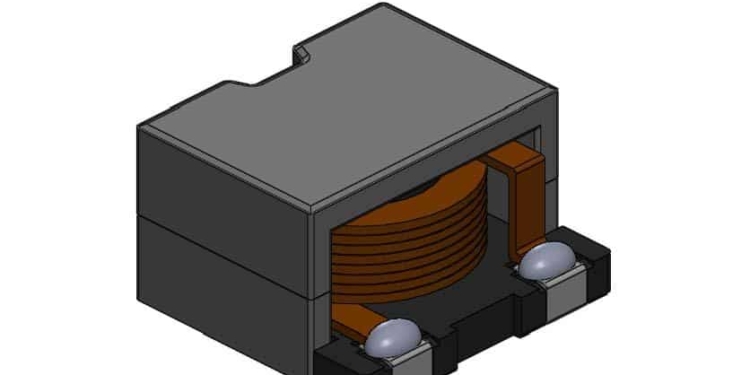source: Sumida news
This SMD power inductor series is wound by flat wire and assembled with a Mn-Zn ferrite core. The L values range (lower side) of the existing CDEP15D90/T150 and newly developed 13mm sq. CDEP13D76/T150 was expanded. To meet the high power handling and high insulation voltage demand for automotive applications, the CDEPxxDxx/T150 series which would correspond to high insulation voltage (DC120V) was developed.
The product family family of CDEPxxxxT150 will continue to be further developed in order to expand Sumida’s product portfolio and to fulfil the increasing demand from the market.
Key Features
- AEC-Q200 qualified
- Secured insulation voltage between core and coil (max 120Vdc)
- Operational Temperature range: -40°C ~ +150°C (including self-heating)
Applications
- LED head lighting
- ECU & other high power supply applications for automotive
Electrical Characteristics – CDEP13D76/T150: Standard Types
| Part Name | Inductance (µH)(±20%) ※1 |
D.C.R(mΩ) (±20%) | Saturation Current (A) ※2 |
Temperature Rise Currrent (A) ※3 |
|
| at 20°C at 150°C | |||||
| CDEP13D76T150NP-1R0MC 105 | 1.00 | 1.98 | 31.0 | 21.0 | 20.0 |
| CDEP13D76T150NP-1R6MC 105 | 1.60 | 2.60 | 25.0 | 17.0 | 17.8 |
| CDEP13D76T150NP-2R4MC 105 | 2.40 | 3.30 | 21.0 | 15.0 | 16.1 |
| CDEP13D76T150NP-3R6MC 105 | 3.60 | 3.90 | 17.2 | 11.5 | 15.0 |
| CDEP13D76T150NP-5R1MC 105 | 5.10 | 4.80 | 14.6 | 10.3 | 13.0 |
| CDEP13D76T150NP-6R8MC 105 | 6.80 | 5.90 | 12.7 | 9.00 | 11.5 |
| CDEP13D76T150NP-100MC 105 | 10.0 | 10.3 | 10.5 | 7.30 | 8.50 |
| CDEP13D76T150NP-120MC 105 | 12.5 | 13.4 | 9.30 | 6.50 | 7.50 |
| CDEP13D76T150NP-150MC 105 | 15.0 | 15.2 | 8.50 | 6.20 | 7.00 |
| CDEP13D76T150NP-220MC 105 | 22.0 | 23.4 | 6.90 | 4.70 | 5.30 |
Electrical Characteristics – CDEP13D76/T150: High Power Types
| Part Name | Inductance (µH)(±20%) ※1 |
D.C.R(mΩ) (±20%) | Saturation Current (A) ※2 |
Temperature Rise Currrent (A) ※3 |
|
| at 20°C at 150°C | |||||
| CDEP13D76T150NP-0R8MC-90 | 0.80 | 1.98 | 40.0 | 27.0 | 20.0 |
| CDEP13D76T150NP-1R5MC-90 | 1.50 | 2.60 | 28.5 | 19.0 | 17.8 |
| CDEP13D76T150NP-2R2MC-90 | 2.20 | 3.30 | 24.5 | 16.5 | 16.1 |
| CDEP13D76T150NP-3R3MC-90 | 3.30 | 3.90 | 19.4 | 14.2 | 15.0 |
| CDEP13D76T150NP-4R3MC-90 | 4.30 | 4.80 | 17.2 | 12.2 | 13.0 |
| CDEP13D76T150NP-6R8MC-90 | 6.80 | 7.40 | 13.7 | 9.50 | 10.0 |
| CDEP13D76T150NP-100MC-90 | 10.0 | 13.4 | 11.3 | 7.70 | 7.50 |
| CDEP13D76T150NP-120MC-90 | 12.5 | 15.2 | 10.2 | 7.20 | 7.00 |
| CDEP13D76T150NP-150MC-90 | 15.0 | 19.9 | 9.30 | 6.50 | 6.00 |
| CDEP13D76T150NP-220MC-90 | 22.0 | 30.4 | 7.50 | 5.40 | 4.70 |
Electrical Characteristics – CDEP15D90/T150: Standard Types
| Part Name | Inductance (µH)(±20%) ※1 |
D.C.R(mΩ) (±20%) | Saturation Current (A) ※2 |
Temperature Rise Currrent (A) ※3 |
|
| at 20°C at 150°C | |||||
| CDEP15D90T150NP-0R5MC-125 | 0.50 | 1.20 | 63.0 | 43.0 | 33.5 |
| CDEP15D90T150NP-1R2MC-125 | 1.20 | 1.75 | 41.9 | 28.5 | 24.5 |
| CDEP15D90T150NP-2R0MC-125 | 2.00 | 2.40 | 31.0 | 22.0 | 23.0 |
| CDEP15D90T150NP-3R3MC-125 | 3.30 | 2.90 | 25.0 | 17.0 | 18.5 |
| CDEP15D90T150NP-4R7MC-125 | 4.70 | 3.50 | 21.2 | 14.8 | 16.5 |
| CDEP15D90T150NP-6R2MC-125 | 6.20 | 4.90 | 18.5 | 13.0 | 14.8 |
| CDEP15D90T150NP-100MC-125 | 10.0 | 7.90 | 15.0 | 10.4 | 12.5 |
| CDEP15D90T150NP-120MC-125 | 12.5 | 8.90 | 12.8 | 9.50 | 12.2 |
| CDEP15D90T150NP-150MC-125 | 15.0 | 10.6 | 12.0 | 8.40 | 8.50 |
| CDEP15D90T150NP-220MC-125 | 22.0 | 14.5 | 9.60 | 6.60 | 7.50 |
Electrical Characteristics – CDEP15D90/T150: High Power Types
| Part Name | Inductance (µH)(±20%) ※1 |
D.C.R(mΩ) (±20%) | Saturation Current (A) ※2 |
Temperature Rise Currrent (A) ※3 |
|
| at 20°C at 150°C | |||||
| CDEP15D90T150NP-1R0MC-100 | 1.00 | 1.75 | 51.6 | 35.8 | 24.5 |
| CDEP15D90T150NP-1R6MC-100 | 1.60 | 2.40 | 42.0 | 28.0 | 23.0 |
| CDEP15D90T150NP-2R4MC-100 | 2.40 | 2.90 | 34.5 | 24.5 | 18.5 |
| CDEP15D90T150NP-3R6MC-100 | 3.60 | 3.50 | 26.5 | 18.5 | 16.5 |
| CDEP15D90T150NP-4R7MC-100 | 4.70 | 4.90 | 24.0 | 16.6 | 14.8 |
| CDEP15D90T150NP-6R8MC-100 | 6.80 | 5.50 | 20.4 | 13.8 | 13.5 |
| CDEP15D90T150NP-100MC-100 | 10.0 | 8.90 | 16.3 | 11.6 | 12.2 |
| CDEP15D90T150NP-120MC-100 | 12.5 | 10.6 | 15.0 | 10.3 | 8.50 |
| CDEP15D90T150NP-150MC-100 | 15.0 | 13.4 | 13.4 | 9.60 | 8.00 |
| CDEP15D90T150NP-220MC-100 | 22.0 | 20.1 | 11.0 | 7.50 | 6.50 |
※ 1 Measuring frequency at 100kHz 0.1V
※ 2 Saturation current: This indicates the actual value of D.C. current when the inductance becomes 30% lower than its nominal value.
※ 3 Temperature rise current: The actual value of D.C. current when the temperature of coil becomes △T=40°C (Ta=20°C).
Please note that when using the product while applying current with audio-frequency (AF) signals may results in audible noises due to magnetostriction. Also, in order to avoid an audible noise problem, operating with non-AF signals would be recommended. The noise amplify depending on the coil mount area on the PCB.
Production
CDEP13D76/T150: in July 2017
CDEP15D90/T150: in series production
(Note: Though all samples are available now, series production for below 4.7uH L values parts for both types will be launched the series production in Q4 2017.)
































